The Gift of South Dakota
Subscriptions to South Dakota Magazine make great gifts!
Subscribe today — 1 year (6 issues) is just $29!
Scars from the Sky
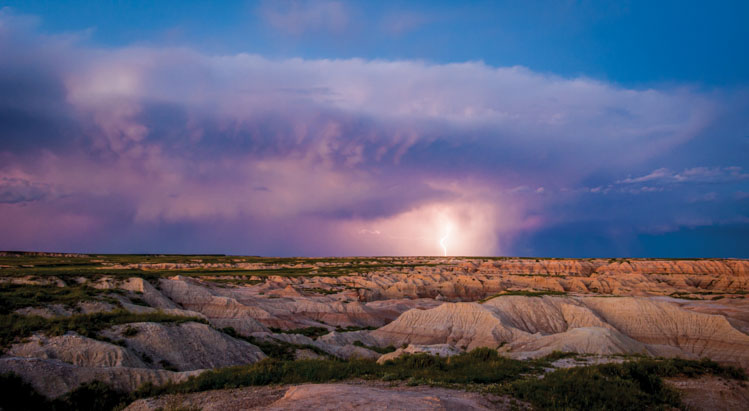 |
| A lightning strike beyond the Badlands. Photo by Greg Latza. |
As a little girl, my great-grandmother found lightning terrifying. She saw plenty of it growing up in the Mississippi River Valley, but not the bolt that seemingly came from nowhere and slammed her to the ground.
She was 12 then and survived, obviously. I wouldn’t be here to tell her story if she hadn’t. Strangely, this girl with a lightning phobia never feared it again after that day and was, in fact, somewhat lackadaisical about it.
On second thought, maybe that isn’t so strange, because encounters with lightning often change people. I heard my great-grandmother’s descendants speculate that perhaps she had a near-death experience that changed her view of life. Or maybe she took the old adage about lightning never striking twice literally. A psychologist friend of mine theorized that before being struck, she considered lightning certain death. Understanding that it wasn’t necessarily so was enough to dissolve her phobia.
Between 75 and 80 percent of people struck by lightning survive, as does the majority of livestock, though that’s harder to measure. An examination of our forests proves that thousands of trees live through
lightning, too — some multiple times across decades. Gary Say, a retired Forest Service forester who fought wildfires across the west for 30 years, says the percentage of trees struck by lightning that burst into flame is only about 1 percent.
The lightning I’ve known in South Dakota is every bit as intimidating (or impressive, depending on your point of view) as the strikes my great-grandmother saw generated by Mississippi Valley summer storms. Florida is the number one state for lightning strikes, but next are the states comprising Tornado Alley, right up the center of the nation. On open South Dakota prairies, you can watch as a lightning storm brews miles away. You can monitor whether it’s coming toward you or moving a different direction and calculate its distance by counting seconds between a flash and the sound of thunder reaching your ears.
One night in Stanley County, I watched two big storms collide. Wind forced me to pull my car off the road far from any shelter, and I sat in awe watching lightning hit the ground 360 degrees around me, more strikes per minute than I could count. How close? The storm wasn’t exactly on top of me, but it proved pointless to count the seconds whenever a big bolt hit. After half an hour the show was suddenly over and a calm, cool night followed.
It’s no wonder, I thought, that Crazy Horse — who knew these prairies and their seasonal moods well — saw lightning as symbolizing his own mighty power.
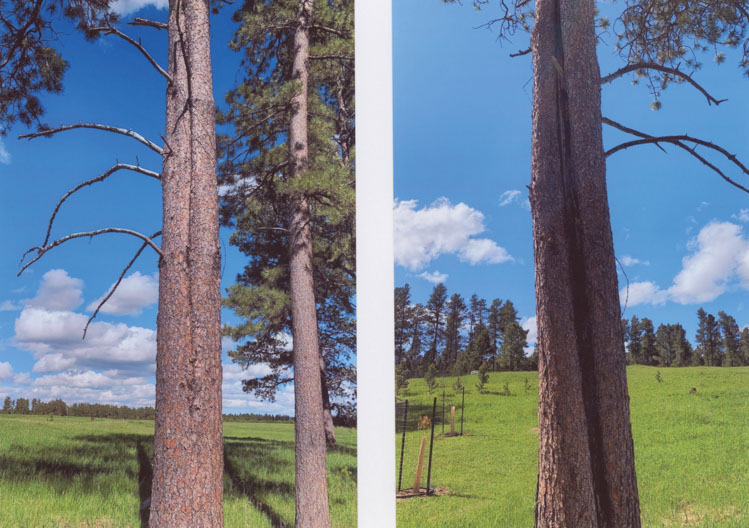 |
| Long vertical splits are telltale signs that a tree has been struck by lightning. |
The most terrifying South Dakota lightning is experienced in a boat on the Missouri River or a big lake in the northeast. The most consistently spectacular, it can be argued, is found in the Black Hills. Thunderstorm researcher Tom Warner, a native Californian who made Rapid City his observation base after Air Force service, says that the Hills see more positive cloud-to-ground lightning than most places, typically producing strikes of longer duration and carrying greater charge. Thunder that reverberates down canyons may sound as if lightning is bouncing off granite pinnacles and limestone cliffs, but Warner notes that those geological features are only rarely hit. Man-made targets like fire lookouts, tall buildings and cell phone and wind turbine towers trigger more lightning than rocky peaks.
The Black Hills can offer a false sense of security. If you’re in a canyon and the sky above is blue, you’ll never guess it’s black and menacing just beyond the rim and moving your way. And when lightning develops in a canyon, it’s easy to think, “How could it possibly find me under the cliffs and hidden among trees?”
That’s what Black Hills people asked about Gage McSpadden, struck and killed while playing disc golf on a course tucked into the mouth of Spearfish Canyon in July of 2015. A well-known cross-country and track athlete at Black Hills State University, his death generated lots of press and was listed as one of 28 lightning fatalities in the United States that year. Press accounts reminded readers that not all lightning strikes are direct. It seemed the bolt that killed McSpadden (and seriously injured a companion) first hit a metal disc cage and expanded outward as the men approached.
Ken Sargent, originally from Martin and now living in Denver, doesn’t know whether he took a direct or indirect hit near Mount Rushmore on July 20, 1985. He can’t recall the strike itself and has relied on the account of a friend who was present in recreating the scene. She waited in a car as Sargent completed a non-technical rock climb. He descended the granite and was cooling off before getting into the car. The day was overcast but there had been no thunder or lightning.
“I was fooling around and I picked up a pine cone, pretended it was a grenade and that I was pulling the pin,” Sargent says. “Then I threw it at the car.”
Boom!
Lightning hit, “but my friend thought I was still fooling,” Sargent continues. “I got to the car and was saying, ‘My bones ache! My God, they ache so much!’”
He climbed into the driver’s seat, started the engine, and promptly drove into the ditch. At that point the friend took over; there’s no doubt she saved his life. She drove Sargent to medical assistance in the days before 911, and then he was loaded into an ambulance and rushed to Rapid City Regional Hospital. On the way, his heart and breathing ceased three times.
Sargent survived, but the adventure sapped his strength. “I was a young guy, early 20s, fit, always riding a mountain bike up Spearfish Canyon,” he says. “Then, all of a sudden, I’m turning into an old man.”
A neurologist advised Sargent that coming back would be a long road. “It took me months,” Sargent says. Cycling and therapy in a pool helped his body return to normal, but what happened to him emotionally and spiritually is permanent.
“After you die, like I did in the ambulance, you’re always aware of how fast everything in life can change,” Sargent explains. “And it was more than that. I thought about what’s beyond this life, about the eternal. I began to reconcile my life as I had lived it with how I should live it. I’ve been a good person ever since.”
Tom Kuck has never been struck by lightning, but he came close enough to understand how the experience changes survivors. He owns land in the Black Hills at Moon — one of the best spots on the continent to observe lightning. “We’re on top of the western edge of the Black Hills, 2,000 feet above Newcastle, Wyoming,” says Kuck, a retired wildlife biologist who lives most of the year in Aberdeen. “We can see storms develop and move across the Wyoming plains and it seems like they intensify when they hit the edge of the Hills.”
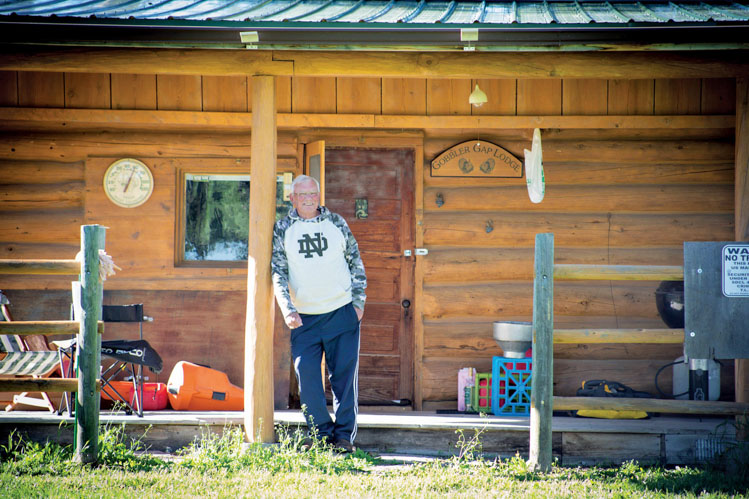 |
| Ton Kuck's cabin on the western edge of the Black Hills lies within a lightning hot spot. |
“He’s right,” confirms Bob Riggio, who has monitored South Dakota weather for almost 50 years, many of those as a meteorologist at Rapid City television station KNBN. “The Black Hills provide extra updraft as storms move in, coming usually from the west. Updrafts are how thunderstorms get their energy. Often, although not always, these storms start dying as they go into a downdraft on the eastern side of the Hills.”
One day in early summer 2009, Kuck drove six and a half hours from Aberdeen to his cabin at Moon. He decided to mow, knowing rainy weather was approaching. But it didn’t seem imminent.
“I was on the lawn mower and there was a flash and a kaboom at the same time,” he recalls. “It was like a bomb going off above me and it took my breath away. I could taste and smell something like sulphur, and my hair stood straight out.”
The next day he found the pine that had been hit, about 50 yards from where he had been mowing. That’s a long pass in football, but too close for comfort in a lightning storm. Kuck hadn’t given much thought to lightning in all his years in the field as a biologist, but that changed after he witnessed the incredible power up close.
“I’m much more aware,” Kuck says. “Now, when it starts to rumble, I take cover.”
The tree that was hit didn’t burn and wasn’t split open. But Kuck quickly knew it was dead, apparently killed instantly. Needles dropped and no parts of the tree showed signs of life again.
Three years after his close call on the mower, Kuck was asked by the state forester if he would like trees on his property inspected for pine beetles so that afflicted ones could be sprayed to slow the bugs’ spread. Kuck said yes, and during the inspection noticed far more evidence of past lightning strikes than beetle infestations.
“If you count all the trees on my property, most are lightning survivors,” Kuck says. The most common scarring is a telltale vertical split in the bark, often blackened, and sometimes extending to the ground.
Thirty-five years ago, one of Kuck’s trees was split far deeper than the bark. “It was opened up but has been healing and is closed again now,” he says. “Thirty-five years and lightning still hasn’t killed it.”
Lightning isn’t going anywhere. There’s never been a “warp speed” plan for eradicating it, and if we could, would we want to? In some remote areas of the world, fires caused by lightning every few years are the only way certain forests can regenerate. In America, lightning is deeply ingrained in our culture — from tales of Crazy Horse and Benjamin Franklin to mood-setting presences in horror films, classic rock ‘n’ roll lyrics and similes we’ve all uttered: “The answer came to me like a lightning bolt!”
Still, living in a world full of lightning requires some thought. Not to disparage my great-grandmother, but being phobic about this natural force, as she was for her first 12 years, isn’t good. Nor is being lackadaisical, as she was for her last 70. There has to be a middle ground.
Warner believes more and more people are taking rational actions these days, citing fewer injuries and fatalities nationally over the past few years. “They’ve learned, I think, that if you hear thunder, you’re close enough to be struck,” he says. “And actually, you don’t have to be struck to be injured by ground current. When you’re touching metal or standing under a tree during lightning, you’re at risk of becoming part of the conduit channel.”
Indoors is the best place to be when conditions develop, Warner says. Inside a vehicle offers good protection, too. But the pines have to stand tall and steadfastly weather the storm, just as they have for centuries.
Editor’s Note: This story is revised from the November/December 2020 issue of South Dakota Magazine. To order a copy or to subscribe, call (800) 456-5117.


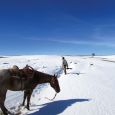




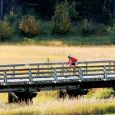


Comments